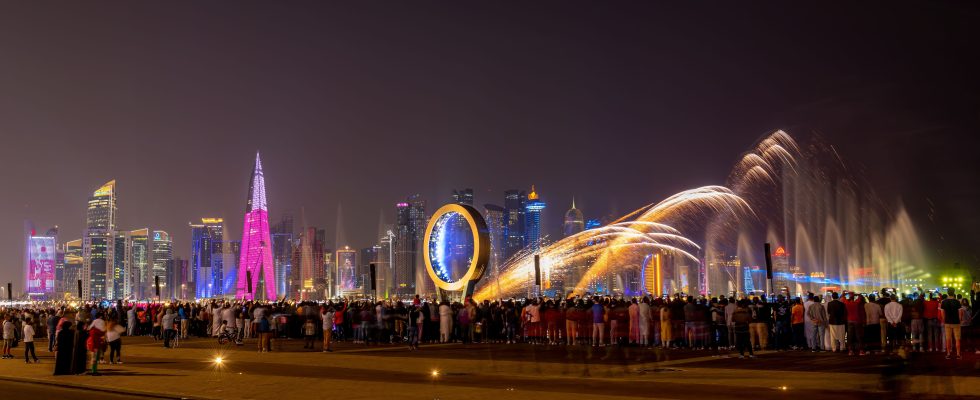This Sunday, December 18, 2022, the Football World Cup has just ended. Night has fallen for many hours in Doha. At the foot of the boulevards of The Pearl, an ultra-luxurious artificial archipelago of the Qatari capital, kilometers of traffic jams form, and burgundy flags flutter from the windows of pick-up trucks. Most Qataris are celebrating the gift given by the kingdom one last time.
However, some people are not in the mood to party. The manager of one of the marina’s establishments watches, with a sad expression, the foreign tourists leaving his palace: “How are we going to fill our hotels now?” he asks himself, pulling on his cigarette. The question sums up the challenge facing Qatar: succeeding in reusing its infrastructure to become a popular tourist destination on the Arabian Peninsula. And this permanently.
A tourism powerhouse by 2030?
The petromonarchy has spent more than 200 billion dollars for its World Cup. The country has commissioned 250 to 280 hotels in the capital alone. Motorways are emerging at high speed. An ultra-modern RER network now connects Doha to the country’s largest cities. Many players in the economic world, such as Amer al-Mana, the sales director of the Almana Motors group, distributor of several major Western car brands, consider that the World Cup has enabled the building of a “new Qatar” and will serve to develop entire sectors of the national economy. In the lead, tourism.
Emir Tamim bin Hamad al-Thani has set a course. As part of the Qatar National Vision 2030 plan which aims to make the peninsula less dependent on its gas exports, the country must derive 12% of its GDP from this sector of activity by 2030. 6 million visitors are expected , compared to 2 million today. To make the destination attractive, Qatar has focused in particular on architecture. He brought in the best. The national museum was designed by Frenchman Jean Nouvel, Pritzker Prize winner – the equivalent of the Nobel for the discipline. The Museum of Islamic Art was designed by the Chinese Ieoh Ming Pei, also a Pritzker Prize winner. To attract more sun-loving vacationers, the emirate has also developed several artificial beaches. With heat peaks exceeding 50 degrees almost daily, the peninsula has invested massively in air conditioning.
Despite its voluntarism, Qatari policy is however undermined by the lead taken by its neighbors, underlines David Rigoulet-Roze, doctor of political science specializing in the Middle East: “Since the end of its World Cup, Qatar must to face the progression of two strongholds of tourism in the region: the United Arab Emirates and, above all, Saudi Arabia.” The former, thanks to the attractiveness of Dubai, are already well established in the segment of what the researcher calls “Miami vacations”. Influencers, footballers, singers…, the destination has become popular. Having notably removed the barriers on alcohol linked to religion, the United Arab Emirates embody a vacation spot where everything is possible in the heart of the Arabian Peninsula. “Qatar is not ready to break away from its conservatism,” insists the researcher.
It is closer to the Saudi model. The country led by Mohammed ben Salmane is developing, like its neighbor, an offer based on traditional journeys, particularly in the Rub al-Khali desert. However, Doha cannot compete with the geography of a State… 200 times larger. “Nine months after the World Cup, they find themselves with magnificent hotels of 300 rooms with only 30 customers inside,” laughs a Frenchman used to the palaces of the peninsula.
However, Qatar is taking advantage of a path in which it has always excelled: “sport tourism”. The country thus hosts a slew of major international competitions. He organized the world judo championships the day after the Football World Cup. Doha is also preparing to host major swimming, Formula 1 and tennis events.
The model has worked well since the Handball World Cup in 2015. The infrastructure built for the occasion is regularly reused to hold other competitions, and Qatar is recognized for its organizational know-how. But can this success be transposed to the eight brand new football stadiums? It will be difficult to fill them all year round, when the territory has barely… 6,000 licensees. On the government side, we want to be reassuring. The speakers, it is claimed, will be used during the Asian Football Cup next summer – which was initially to be hosted by China – and will attract tourists.
Sports tourism, a diplomatic weapon
These kinds of events also represent a way to take care of one’s relationships with the outside world. “Sports tourism is a diplomatic weapon for Qatar. It is an opportunity to bring important people to its soil and to give a good image of the country,” notes Raphaël Le Magoariec, doctoral student within the world team. Arabic and Mediterranean (Emam) from the University of Tours.
On this point, Qatar seems to have succeeded in its World Cup. The competition notably made it possible to promote its airline Qatar Airways. By bringing in nearly 3 million spectators, it has built up a significant level of sympathy among international tourists. According to the polling company YouGov, all its reputation indicators have climbed in the minds of French customers. The reopening of the Nice-Doha line at the beginning of May, as well as the launch of the Lyon-Doha connection at the beginning of July, bear witness to this. “Qatar can be satisfied with this type of success, but, in reality, it is still too early to know if the World Cup has had a lasting impact,” says Raphaël Le Magoariec. The government itself has defined it: it is by 2030 that Qatar will make the definitive assessment of “its” World Cup. See you in seven years.
